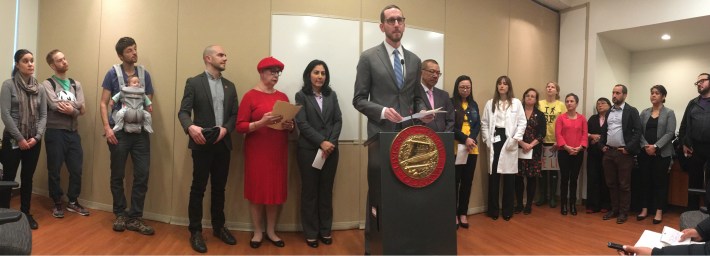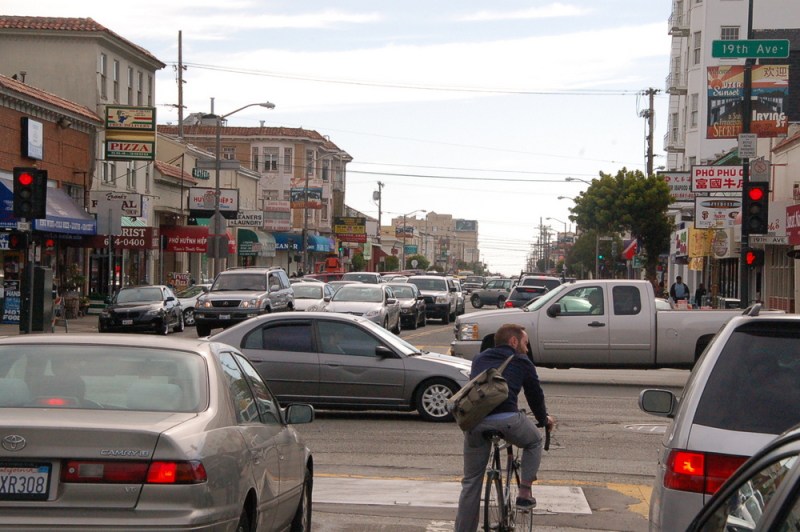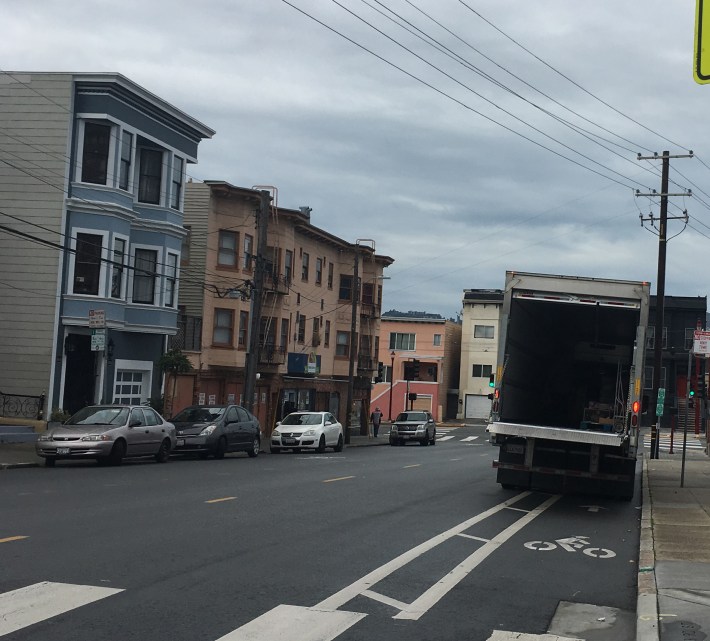Note: GJEL Accident Attorneys regularly sponsors coverage on Streetsblog San Francisco and Streetsblog California. Unless noted in the story, GJEL Accident Attorneys is not consulted for the content or editorial direction of the sponsored content.
Senator Scott Wiener introduced a state bill today that would require Caltrans to incorporate "Complete Streets” design in its highways. That is, it would require the department to consider the needs of all users of a road, including people walking, biking, and taking transit--not just car drivers. S.B. 127 is stronger and more thorough than the Complete Streets bill Wiener introduced last year but let die when Prop 6 threatened to disrupt new gas tax revenue.
The new bill would require Caltrans, the California State Transportation Agency, and the California Transportation Commission to give high priority to safety for pedestrians and bicyclists and to building bicycle and pedestrian facilities. Caltrans has always claimed that safety is its top priority. But it has been slow to acknowledge how its car-focused street designs have created places that are dangerous for people who are not in cars.
The bill would also require existing state transportation funding programs to prioritize pedestrian and bicyclist safety. It would require community outreach to ascertain what residents need and want in their neighborhoods.
It would require the California Transportation Commission to adopt performance measures that show progress, or lack thereof, on the conditions of bicycle and pedestrian facilities, and on how easy or safe it is to for pedestrians, bicyclists, and transit riders to navigate them. It would require that the State Highway Operation and Protection program incorporate pedestrian and bicyclist needs into the projects it funds.
It would require clear reporting on how much money is spent on bicycle and pedestrian infrastructure--something that is currently very difficult to separate out in project budgets and therefore very difficult to measure and account for.
In other words, S.B. 127 would require the state to acknowledge that not every road user is, wants to be, or can be in a car. It calls for a long-overdue paradigm shift in how transportation projects are prioritized and funded in California.

At a press conference this morning at San Francisco General Hospital, a long list of speakers articulated many reasons the bill is needed. Jenny Yu, founder of Bay Area Families for Safe Streets, told the harrowing story of her mother, who continues to suffer years after surviving being run down in a crosswalk. Dr. Rebecca Plevin of San Francisco General Hospital quoted startling statistics: Of the 4,000 traumatic injuries the hospital treats each year, half are the result of traffic collisions, and half of the injured are pedestrians and cyclists. People who are walking or biking make up three quarters of traffic-related deaths in the city, she said.
San Francisco Supervisor Norman Yee said that the new state policy would complement that city's current Complete Streets policy. Bea Cardenas Duncan of the American Heart Association pointed out how important safe street designs are for seniors, who need to be able to move safely through their towns and cities to stay healthy.
CalBike senior policy advocate Linda Khamoushian thanked Senator Wiener for his "unwavering commitment" to the goals of safer streets for everyone. "Some of the most dangerous and uninviting spaces [in our cities] are Caltrans roads--what are called state highways but we know of as our homes, as ways to get to schools, shopping, places of worship," she said. Caltrans, by focusing for years on designing to make driving easier, has not only created dangerous roads but also "lost opportunities to bring bikeable and walkable spaces to our communities."
"We have systematically designed health and affordable transportation out of our lives," she said, adding that this bill is a remedy for that.
Senator Wiener said his goals with S.B.127 are threefold: to increase safety, to help people live healthier lives by encouraging more use of active transportation modes, and to create better climate outcomes by giving people the option to use environmentally friendly travel modes. "That can only happen if it's safe to do so," he said.
The bill applies to state highways controlled by Caltrans, which in many cities are surface streets. In some smaller cities, the state highway is the main--sometimes only--local street. A few examples are 19th Avenue, Van Ness, Sloat, and Lombard in San Francisco; Ashby and San Pablo avenues in East Bay cities; El Camino Real on the Peninsula; Sepulveda and Santa Monica boulevards in L.A.; and 24th Street in Bakersfield.
"Caltrans has historically treated these surface streets as if they were the same as a major traditional highway," said Senator Wiener, "and they're not. We need to make sure these streets are safe for all users."
S.B. 127 would require projects paid for via the highway maintenance fund to incorporate complete streets elements, he said. "For example, you have to have a sidewalk. You have to take into account how pedestrians are going to safely cross the street, and how people can access a bus in a safe way."
"We are going to flip the default," said Senator Wiener. "Right now, you have to get a waiver to do bike and pedestrian improvements. We're going to make the default that Caltrans will automatically include those improvements, and if they don't, they need a waiver."
Caltrans is so famous for resisting and blocking efforts to redesign streets for safety that redesign efforts are frequently killed before they're fully articulated. And while Caltrans has been trying to address some of these issues, creating a sustainability office and a pedestrian and bicycle engineering division, its progress is glacial. S.B. 127 would force the department to move faster on safety for everyone, and to meet some of these goals within the next few years.
The bill will probably meet stiff resistance from the car-is-king, congestion-is-the-only-real-traffic-problem crowd, but that will be a good discussion to get into the public realm.







